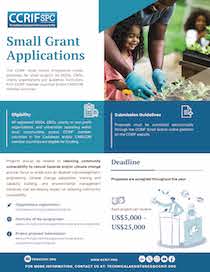Grand Cayman, 2 August, 2011 – As the 2011 Atlantic Hurricane Season gets underway, the Caribbean Catastrophe Risk Insurance Facility (CCRIF) is providing assistance to Caribbean nations to prepare for the tropical cyclones that are expected to affect the region. This assistance takes two forms. The first is that CCRIF has made available its Real-Time Forecasting System (RTFS) to all its members. The RTFS is a storm impact forecast tool which provides users with real-time hurricane hazard and impact information and can support users in effective disaster preparedness and response, evacuation decision making, planning for pre-positioning of equipment and supplies as well as in contingency planning to secure critical infrastructure and operations prior to a hurricane. This is the fourth year in which the RTFS has been made available by CCRIF. A total of 146 persons have registered for access to the RTFS this year, a 60% increase over last year.
The second form of assistance provided by CCRIF to its members relates to the provision of training in the effective use of the RTFS. During July, in collaboration with the Caribbean Institute of Meteorology and Hydrology (CIMH) and Kinetic Analysis Corporation (KAC), CCRIF provided two sets of training on the RTFS. Seventy-eight persons from 18 countries in the Caribbean region participated in the two-day online training course (delivered through the newly established CCRIF online training site) entitled, Understanding the Real-Time Forecasting System – a Practical Course Designed to Strengthen Caribbean Governments’ Disaster Response and Mitigation Capacity. The training focused on improving participants’ understanding of hurricane risks, provided them with general information on what forecasting is and what it involves, while introducing its limitations. Equal importance was placed on exposing participants to various topics including: the key features of the RTFS product; understanding the RTFS modelling platform; application of the RTFS; selecting locations to be included in the RTFS product; and an introduction to the use of Google Earth, the platform through which the RTFS product is delivered.
Participants included personnel from disaster management departments and meteorological offices, ministries of planning, agriculture and finance as well as a number of international development agencies working in countries across the region in disaster risk management. Participants felt that the training was a success and in the evaluation completed by them, 94% indicated that the course was very good with over 80% of them indicating that the course content as either excellent or very good.
CCRIF believes that this training – as well as providing access to the RTFS – is timely and represents significant progress in disaster risk management for the region. According to Dr Simon Young of the CCRIF Facility Supervisor team, “The RTFS will no doubt enable our countries to be better prepared to manage the potential impact of the storms during this year’s Hurricane Season.” In fact, the National Oceanic and Atmospheric Administration (NOAA) announced that it expects more storms than average in 2011. During the 2011 hurricane season, which spans June 1 to November 30, NOAA is forecasting 12 - 18 tropical storms, 6 - 10 hurricanes and 3 - 6 major hurricanes with winds of 111 mph or greater. The first storm, Arlene, developed on June 29 in the Gulf of Mexico and struck Veracruz, Mexico, killing 25 people. Through July, activity occurred at an above normal pace with the formation of three named storms, and the National Hurricane Center is expecting Tropical Storm Emily to form within the first few days of August.
According to Ms Ekhoseuhi Iyahen, of the CCRIF Facility Supervisor team and facilitator on the RTFS course, “Many of our members have used the RTFS and can attest to its value. In fact, when Hurricane Tomas struck CCRIF members Barbados, Saint Lucia and St Vincent & the Grenadines in October 2010, prior preparations using real-time storm impact forecasts from the RTFS played a positive role in reducing damage levels in these countries and also helped to minimise loss of life during the storm.”
About CCRIF: CCRIF is a risk pooling facility, owned, operated and registered in the Caribbean for Caribbean governments. It is designed to limit the financial impact of catastrophic hurricanes and earthquakes to Caribbean governments by quickly providing short term liquidity when a policy is triggered. It is the world’s first and, to date, only regional fund utilising parametric insurance, giving Caribbean governments the unique opportunity to purchase earthquake and hurricane catastrophe coverage with lowest-possible pricing. CCRIF represents a paradigm shift in the way governments treat risk, with Caribbean governments leading the way in pre-disaster planning.
CCRIF was developed through funding from the Japanese Government, and was capitalised through contributions to a multi-donor Trust Fund by the Government of Canada, the European Union, the World Bank, the governments of the UK and France, the Caribbean Development Bank and the governments of Ireland and Bermuda, as well as through membership fees paid by participating governments.
Sixteen governments are members of the fund: Anguilla, Antigua & Barbuda, Bahamas, Barbados, Belize, Bermuda, Cayman Islands, Dominica, Grenada, Haiti, Jamaica, St. Kitts & Nevis, St. Lucia, St. Vincent & the Grenadines, Trinidad & Tobago and the Turks and Caicos Islands.
From its inception in 2007 to 2010, 8 CCRIF policies were triggered in 7 member countries, resulting in a total payout to date of US$32,179,470. Of these 8 policies, 3 were for earthquakes and 5 for hurricanes. Saint Lucia received two payments – one for an earthquake in 2007 and one for Hurricane Tomas in 2010.
For more information, contact CCRIF at pr@ccrif.org or visit the website at www.ccrif.org.
English





